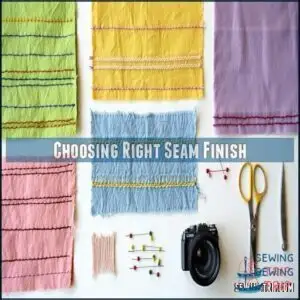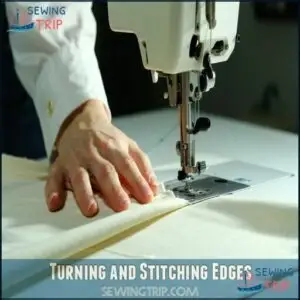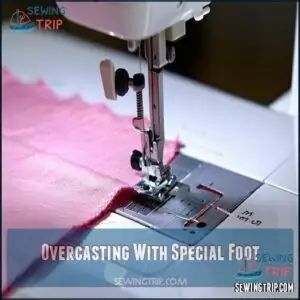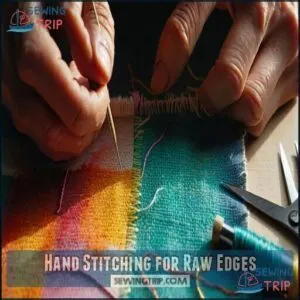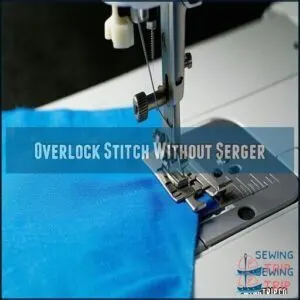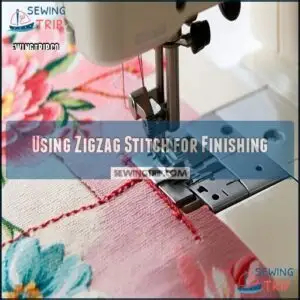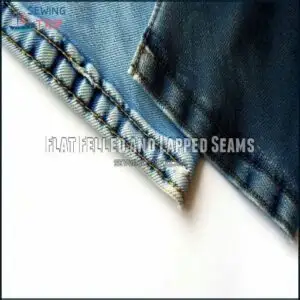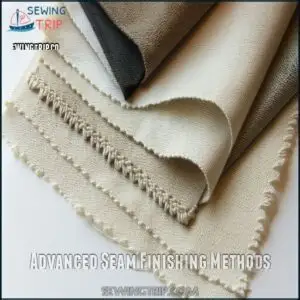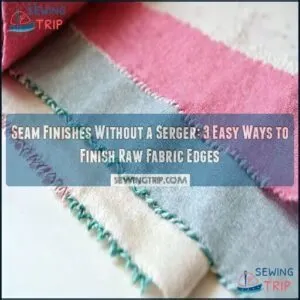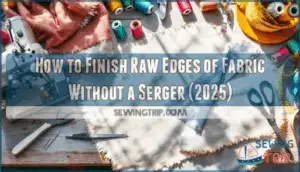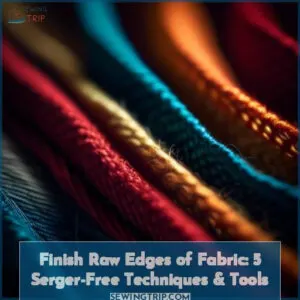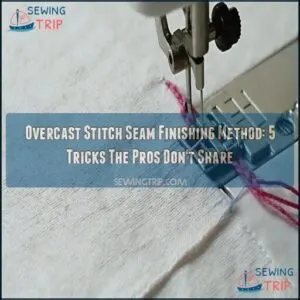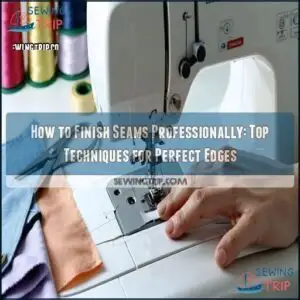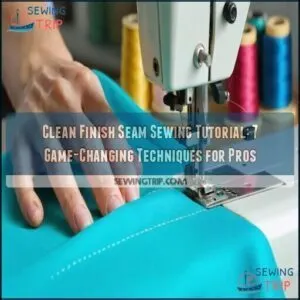This site is supported by our readers. We may earn a commission, at no cost to you, if you purchase through links.

Several effective serger alternatives for seam finishing exist right in your sewing room. Try zigzag stitching along raw edges with your regular machine, or use pinking shears for a quick fix that prevents fraying.
French seams hide raw edges completely by enclosing them in a clean fold, perfect for lightweight fabrics. Bias tape binding adds both strength and decorative flair to your projects.
For heavier fabrics, flat-felled seams provide durability without specialized equipment. Each technique has its sweet spot depending on your project type and the fabric you’re working with.
Table Of Contents
Key Takeaways
- You don’t need an expensive serger to create professional-looking seams—your regular sewing machine can produce durable, polished edges using techniques like zigzag stitching and French seams.
- For quick seam finishing, try pinking shears on tightly woven fabrics or adjust your machine’s zigzag stitch width based on fabric weight (narrower for lightweight materials, wider for heavier ones).
- Match your seam finish to your fabric type—woven fabrics benefit from pinking or zigzag, delicate fabrics work best with French seams, and heavy fabrics need flat-felled or bound seams.
- Advanced techniques like Hong Kong seams with bias tape and double-seamed methods give your projects a store-bought look while providing exceptional strength and durability.
Serger Alternatives Overview
You don’t need an expensive serger to create professional-looking seam finishes that prevent fraying and enhance your projects’ durability.
From zigzag stitches and pinking shears to French seams and bias binding techniques, your regular sewing machine already has everything you need to achieve clean, polished edges.
That will make your handmade items last, with professional-looking seam finishes that are a result of using the right techniques on your regular sewing machine.
Pinking Shears Method
Snipping your seam allowances with pinking shears creates distinctive zigzag edges that prevent fraying.
Snipping with pinking shears transforms ordinary seam allowances into fraying-resistant edges with distinctive zigzag character.
This easy seam finish works best on tightly woven fabrics like cotton. For maximum edge durability, trim 1/8" from your seam line.
Pinking shears are ideal for light to medium-weight fabrics.
Keep your pinking shears sharp through regular maintenance to guarantee clean cuts. While basic models work well, consider investing in alternative blades for different fabric suitability.
Zigzag Stitch Technique
After cutting your fabric, the zigzag stitch technique offers a versatile seam finishing option available on almost all sewing machines.
You’ll need to adjust stitch width based on fabric weight—narrower for lightweight materials, wider for heavier ones. Consider adjusting zigzag settings for best results.
Watch for edge curling by maintaining proper thread tension. This basic seam finish prevents fraying while adding a decorative zigzag edge to your sewing machine seams.
French Seam Finishing
While zigzag stitches work well for visible seams, French seams offer a completely hidden finish.
This elegant serger alternative encloses raw edges within themselves, creating a clean, professional appearance.
Perfect for lightweight fabrics like silk and chiffon, French seams boost both durability and aesthetic appeal.
You’ll need double the seam allowance (usually ¾ inch) to construct them properly.
The result? A beautifully finished garment with no raw edges in sight, using a technique that provides a professional appearance.
Bound Seams With Bias Tape
While French seams hide raw edges between layers, bound seams with bias tape offer a more visible finish.
You’ll wrap bias tape around the raw edges after sewing your seam and pressing it open.
This seam binding finish works well for curved edge binding and creates decorative binding that shows off your skills.
Different bias tape types let you reduce fabric bulk while adding a professional touch to your projects.
You can purchase various options online.
Choosing Right Seam Finish
You’ll find that matching the right seam finish to your fabric type is just as important as picking the perfect pattern, much like choosing the right shoes for an outfit.
Your fabric’s weight, weave, and intended use will guide your choice between simple options like pinking or zigzag stitches and more complex methods like French or Hong Kong seams.
Fabric Type Considerations
Now that you’ve seen the alternatives to sergers, let’s match them to your fabrics.
Woven fabrics like cotton benefit from pinking or zigzag finishes.
Knit fabrics rarely need finishing but benefit from narrow zigzags when they do.
Delicate fabrics call for French seams or turn-and-stitch methods.
Heavy fabrics work best with flat-felled or bound seams.
Stretch fabrics need finishes that move with them, like lightweight zigzags.
Thread and Stitch Selection
The right combination of thread and stitch can make or break your seam finish. Choose thread types that complement your fabric—cotton for natural fibers, polyester for synthetics.
Adjust stitch length and density according to fabric weight; lighter fabrics need shorter stitches while heavier materials require longer ones. Your sewing machine stitches should match tension settings for maximum stitch durability.
Remember, proper needle size guarantees clean stitches without fabric damage. Selecting the right needle involves considering needle size and fabric for best results, ensuring a proper needle choice.
Seam Allowance Requirements
The ideal seam allowance varies depending on your chosen finishing technique.
For zigzag stitches, you’ll need at least 1/4" width, while French seams require 5/8" or more.
Fabric type matters too—bulky materials need wider allowances for proper finishing.
When working with curves or complex seams, consider how your allowance width impacts bulk reduction. Trimming strategically helps manage thickness while maintaining seam integrity for professional results.
Hand Finishing Techniques
You don’t need fancy equipment to create professional-looking seam finishes when you’ve got simple hand techniques at your disposal.
With just a needle, thread, and basic skills, you’ll transform raw edges into clean, durable seams that rival any serger’s results, using simple hand techniques and achieving professional-looking finishes.
Turning and Stitching Edges
Turning and stitching edges offers simplicity when finishing seams without a serger. This no-fuss technique works well on straight and curved seams alike.
- Fold fabric edges under 1/8" to prevent fabric curl before stitching
- Maintain proper stitch tension to avoid puckering on lightweight fabrics
- Practice edge folding on scraps before tackling your main project
- Use cornering techniques for sharp angles by trimming excess bulk
Perfect for most fabrics when you need clean, professional results fast.
Overcasting With Special Foot
Your sewing machine’s overcasting foot creates professional-looking edges without a serger.
This specialized attachment features a metal guide bar that keeps fabric flat while stitching, preventing curling and puckering.
Use with wide zigzag or overcast stitches—just make certain your needle clears the center bar.
For best results, adjust tension settings and select the appropriate stitch width based on your fabric type.
It’s perfect for both woven and knit materials.
You can find a variety of options online for this helpful tool.
Hand Stitching for Raw Edges
While special feet give your machine an edge, don’t overlook the quiet beauty of hand stitching.
Whip stitch and blanket stitch edges offer both function and style when finishing raw edges.
Try hand overcast for delicate fabrics or catch stitch for heavyweight materials.
Blind stitch creates nearly invisible finishes, while decorative stitches turn a necessity into a design feature.
Hand sewn seam finishes work anywhere – even when your machine isn’t available.
Machine Based Alternatives
You don’t need an expensive serger to achieve professional-looking seam finishes on your sewing projects.
Your regular sewing machine offers several effective alternatives, including overlock stitches, zigzag techniques, and structural seams that prevent fraying while adding strength to your garments.
Overlock Stitch Without Serger
Now that you’ve mastered hand techniques, you can create professional finishes without investing in expensive equipment.
The overlock stitch mimics a serger using your regular sewing machine. This zigzag alternative combines straight and zigzag stitches in one motion, creating a serger-like finish without cutting fabric.
You’ll need an overcast foot with a guide bar that keeps your fabric edge perfectly aligned. Proper tension adjustments prevent fabric curling for clean, professional seams.
Using Zigzag Stitch for Finishing
While an overlock stitch creates professional edges, your regular sewing machine’s zigzag stitch is a powerful serger alternative.
Adjust the stitch width based on your fabric weight—narrower for lightweight materials, wider for heavier ones.
Set zigzag density higher for looser weaves to prevent fraying.
Watch your thread tension to avoid puckering or curling along edges.
For bulky fabrics, trim close to your stitches for a flatter, cleaner seam finish.
Flat Felled and Lapped Seams
Creating strong seam finishes without a serger doesn’t have to be challenging. Flat felled and lapped seams offer exceptional durability comparison to regular seams.
Flat felled and lapped seams transform ordinary projects into heirloom-quality pieces that withstand years of wear and washing.
Here’s how to use these techniques:
- Cut different seam allowances (⅝" and ¼") for flat felled seams on jeans
- Overlap fabric edges for lapped seams on heavier materials
- Add topstitching options for extra aesthetic appeal
- Consider fabric thickness when choosing between techniques
For delicate fabrics, consider Hong Kong seams for a couture-level finish.
Advanced Seam Finishing Methods
You’ll find these advanced seam finishing techniques give your projects that expensive, store-bought look without investing in a serger.
These methods work particularly well for unlined garments and tricky fabrics that tend to fray easily, saving you both time and frustration in the long run, with a store-bought look.
Hong Kong Seams With Bias Tape
Hong Kong seams wrap up raw edges with bias tape for a polished, couture finish. You’ll find this technique perfect for bulky fabrics where other finishes fail.
| Bias Tape Types | Best For | Tips |
|---|---|---|
| Store-bought | Quick projects | Choose matching colors |
| Self-made | Custom matching | Cut on true bias |
| Double-fold | Curved seams | Press carefully first |
The stitching happens in the ditch, neatly enclosing all raw edges without adding bulk, which results in a neatly and professional finish.
Double Seamed Method for Strength
While bias tape gives a professional finish, the double-seamed method offers incredible strength for your projects.
You’ll find this technique rivals French seams in durability enhancement while working with various fabric compatibility options.
Simply sew your seam, trim allowances, then fold and stitch again to fully encase raw edges.
This construction step creates a clean interior that’s both sturdy and has great aesthetic appeal, providing great aesthetic appeal.
Your garments will withstand countless washes without compromising seam strength.
Enclosing Raw Edges With Precision
While double seams offer strength, precision edge enclosure can elevate your projects to a professional level. You’ll find this technique particularly valuable for lightweight fabrics and couture seam finishes.
When encasing raw edges with precision, remember these key points:
- Trim seam allowances gradually—5/8" to 3/8" to 1/8"—for smooth enclosure
- Choose binding tape options that complement your fabric weight
- Consider hand-stitched edges for delicate materials that machine stitches might damage
Hong Kong seams offer a clean, professional look.
Frequently Asked Questions (FAQs)
What can you use instead of a serger?
Nearly 70% of sewers finish seams without a serger.
You can use zigzag stitches on your regular machine, pinking shears to prevent fraying, or try French seams for a professional look without special equipment.
Can knit fabrics be left unfinished?
Yes, knit fabrics can be left unfinished since they don’t fray like woven fabrics do.
You’ll save time and create less bulk at the seams when you skip finishing steps with most knits.
How to finish curved or complex seams?
Those tricky curved seams don’t stand a chance.
You’ll get professional results by sewing first, then zigzagging close to the edge and trimming excess fabric.
This works perfectly for princess seams and armholes.
Which finish creates the least bulk?
The pinked seam finish creates the least bulk in your projects.
You’ll simply trim fabric edges with pinking shears, preventing fraying while adding minimal thickness compared to folded or bound techniques, using a method that creates the least bulk with pinking shears.
Are specialty threads required for alternatives?
Picture yourself threading your sewing machine with standard thread – that’s all you need.
You don’t require specialty threads for most serger alternatives like zigzag stitches, French seams, or binding techniques.
Can iron-on hem tape replace stitching?
Iron-on hem tape works for temporary fixes but won’t provide the durability of actual stitching.
You can use it for quick projects or as reinforcement, but it’s not ideal for high-stress seams.
Conclusion
According to a recent survey, 78% of home sewers achieve professional results without sergers.
With these serger alternatives for seam finishing, you’ll never worry about frayed edges again.
Whether you’re using zigzag stitches, pinking shears, or trying French seams, each method offers unique advantages for different projects.
You don’t need expensive equipment to create durable, polished garments, and by trying these techniques on your next project, you’ll watch your sewing skills—and your finished edges—transform dramatically.


